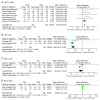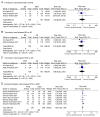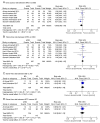Effectiveness and safety of four tract dilation methods of percutaneous nephrolithotomy: A meta-analysis
- PMID: 32256747
- PMCID: PMC7086190
- DOI: 10.3892/etm.2020.8486
Effectiveness and safety of four tract dilation methods of percutaneous nephrolithotomy: A meta-analysis
Abstract
Percutaneous nephrolithotomy (PCNL) has become a routine surgical procedure for treating patients with large kidney stones; the fundamental step in this process is the creation of the nephrostomy tract. In the present study, a meta-analysis was performed to compare the effectiveness and safety of different tract dilation techniques for PCNL. Databases were searched from inception to 1 April 2019 to identify relevant randomized controlled trials. The X-ray exposure time, hemoglobin decrease, stone-free rate, transfusion rate, hospital stay and the complication rate associated with the various techniques were analyzed. A total of 11 studies comprising 1,415 cases were enrolled in the meta-analysis. Significant differences in X-ray exposure time [weighted mean difference (WMD), 30.67; 95% confidence interval (CI), 20.08-41.26; P<0.001] and hemoglobin decrease (WMD, 0.19; 95%CI, 0.15-0.23; P<0.001) were identified between metal telescopic dilation (MTD) and one-shot dilation (OSD). A significantly lower hemoglobin decrease was observed in the balloon dilation (BD) vs. fascial Amplatz dilation (AD) group [WMD, -0.65; 95%CI, -(0.77-0.52); P<0.001]. The transfusion rate was similar between these techniques. The MTD had an obviously higher successful dilation rate compared with that of the OSD, but no significant differences in stone-free rate and transfusion rate were obtained. The present study determined that, compared with other methods, OSD was safer in almost every adult patient, including those that had previously undergone renal surgery; though it is recommended that this should be performed by experienced surgeons. BD was reported to be effective and safer in patients without a history of renal surgery compared to other methods. The present study proposed AD and MTD as safer methods of dilation for patients who have previously undergone kidney surgery.
Keywords: kidney stones; meta-analysis; percutaneous nephrolithotomy; tract dilation.
Copyright: © Wu et al.
Figures








Similar articles
-
Metal telescopic and Amplatz sheath dilation in nephrolithotomy.Urol Ann. 2016 Jan-Mar;8(1):66-9. doi: 10.4103/0974-7796.163795. Urol Ann. 2016. PMID: 26834405 Free PMC article.
-
One-shot dilation versus serial dilation technique for access in percutaneous nephrolithotomy: a systematic review and meta-analysis.BMJ Open. 2019 Apr 20;9(4):e025871. doi: 10.1136/bmjopen-2018-025871. BMJ Open. 2019. PMID: 31005926 Free PMC article.
-
A prospective randomized study comparing the four tract dilation methods of percutaneous nephrolithotomy.World J Urol. 2017 May;35(5):803-807. doi: 10.1007/s00345-016-1929-9. Epub 2016 Sep 10. World J Urol. 2017. PMID: 27614706 Clinical Trial.
-
Four dilation techniques in percutaneous nephrolithotomy: a single-institute comparative analysis.Minerva Urol Nephrol. 2021 Apr;73(2):253-259. doi: 10.23736/S2724-6051.20.03836-9. Epub 2020 Jul 7. Minerva Urol Nephrol. 2021. PMID: 32638574
-
Balloon versus Amplatz for tract dilation in fluoroscopically guided percutaneous nephrolithotomy: a systematic review and meta-analysis.BMJ Open. 2020 Jul 12;10(7):e035943. doi: 10.1136/bmjopen-2019-035943. BMJ Open. 2020. PMID: 32660949 Free PMC article.
Cited by
-
The Saudi urological association guidelines on urolithiasis.Urol Ann. 2024 Jan-Mar;16(1):1-27. doi: 10.4103/ua.ua_120_23. Epub 2024 Jan 25. Urol Ann. 2024. PMID: 38415236 Free PMC article.
-
The effect of percutaneous tract dilation technique on renal parenchymal trauma: An experimental in vivo study on a porcine model.Urol Ann. 2023 Apr-Jun;15(2):191-196. doi: 10.4103/ua.ua_25_22. Epub 2023 Jan 16. Urol Ann. 2023. PMID: 37304519 Free PMC article.
-
Comparison of safety and efficacy of one shot dilation vs. gradual dilation technique in supine percutaneous nephrolithotomy.World J Urol. 2023 Jun;41(6):1659-1666. doi: 10.1007/s00345-023-04393-0. Epub 2023 Apr 11. World J Urol. 2023. PMID: 37039907
-
A novel approach in creating nephrostomy using a double-lumen access sheath during endoscopic combined intrarenal surgery.Transl Androl Urol. 2021 Nov;10(11):4181-4191. doi: 10.21037/tau-21-611. Transl Androl Urol. 2021. PMID: 34984184 Free PMC article.
-
International Alliance of Urolithiasis (IAU) consensus on miniaturized percutaneous nephrolithotomy.Mil Med Res. 2024 Oct 28;11(1):70. doi: 10.1186/s40779-024-00562-3. Mil Med Res. 2024. PMID: 39465407 Free PMC article.
References
-
- Davidoff R, Bellman GC. Influence of technique of percutaneous tract creation on incidence of renal hemorrhage. J Urol. 1997;157:1229–1231. - PubMed
LinkOut - more resources
Full Text Sources
Miscellaneous
